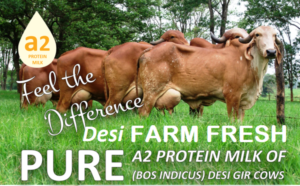CHOOSE A2 MILK INSTEAD OF A1
Milk, considered as complete food for centuries, was consumed extensively by our ancestors, scholars and saints to maintain a healthy and wholesome life. That is because they had access to the pure and truly nourishing A2 milk available from the free-grazing, hygienically bred and sacred cows.

Some of the native breeds from India producing A2 milk include :
- Sahiwal from Punjab,
- Gir from Gujarat, and
- Tharparkar from Rajasthan
- Vechur from Kerala
Some of the above breeds are getting extinct due to large scale cross-breeding and export to European and American countries. Consequently, Gir cow, is now being imported from Brazil and the Brahmi Bull, which is another pure breed, is more popular in Australia.
Benefits of A2 milk
- A2 casein is found to be protective against Allergies (such as gut, skin rashes, hay fever, cough)
- A2 cows milk contains Vitamin D. This could be due to the fact that rays of the sun enter the body of the cow through the hump also imparting a yellowish tinge to the milk.
- Some studies indicate that A2 milk contains the beneficial omega 3 fatty acids . This could be attributed to the diet of the cows consisting primarily fresh green grass which contains the omega 3 fatty acids.
Due to the above factors, desi cow’s milk and ghee and the by products such as urine and dung of the desi cow have medicinal properties and less adverse effects. In India, desi A2 cow milk is marketed under the brand name of Pathmeda in some parts.
Desi Indian cow is a very unique species; can be recognized with the hump on the back and long horns. We need to conserve and protect desi cows to get the best nutrition from milk.
SAVE BABIES FROM TOXIC A1 MILK
Mothers milk is the elixir of life for the baby and with all the speculation surrounding milk proteins and their effects on health; it feels necessary to clarify that mother’s milk contains A2 casein proteins. Most of the casein in mother’s milk is A2 type beta-casein which is better tolerated by infants than formula or regular cow’s milk.
However, it must be noted that mothers who consume large amounts of cow’s milk containing A1 casein may pass on the same to the infant through breast milk.
Research has shown that cow’s milk should be avoided during infan cy and the intolerance to the cow milk proteins is the major cause for diabetes, neurological and developmental problems in later life.
cy and the intolerance to the cow milk proteins is the major cause for diabetes, neurological and developmental problems in later life.
- The BCM-7 produced during metabolism of A1 casein may absorbed faster by babies as their gastrointestinal tract is still immature and developing
- Studies have shown that beta-casein A1 milk is associated as a risk factor for type-1 diabetes, coronary heart disease, arteriosclerosis, sudden infant death syndrome, autism, schizophrenia etc.
- Extensive studies in America and Europe have observed reduction in autism and schizophrenic symptoms with decrease in A1 milk intake.
Other harmful effects of cow’s milk in Infancy
Risk of milk allergy : Early exposure to cow’s milk proteins increases the risk of developing allergy to milk proteins. Gradually as the intestinal tissues develop they become less susceptible to allergy causing substances.
Risk of type 1 diabetes: Studies have shown that exposure to cow’s milk proteins elicits antibody formation to insulin in some children. There is gradual destruction of beta cells producing insulin which in turn manifests diabetes at an early age. Especially in families with a strong history of insulin dependent /type 1 diabetes, it is recommended that commercially available cow’s milk or products containing intact cow milk proteins should be avoided during first year of life.

Renal solute load: Whole cow’s milk contains abundant amounts of proteins, sodium, potassium, chloride and phosphorus which increase the renal solute load. This increases risk of dehydration when water intake is reduced or water losses are increased in infants for some reasons.
Breast milk is the best and most suitable nutritional source for the baby. But if due to some medical or physical circumstances breast feeding is not possible, then we suggest that one should choose buffalo milk after 9 months over cow’s milk or formula feed.
Desi doodh is new health fad
Namita Devidayal| TNN | Apr 23, 2017, 00:29 IST
The best reason to save the desi cow has nothing to do with bovine politics. It is milk. Desi doodh, or A2 milk from indigenous cows, is becoming the latest health fad, with small dairies and big brands like Amul entering the market.
 Much of the cow milk available in the market is A1, from crossbred or foreign cows. Though research is not conclusive, some studies have shown that A1 can trigger inflammation in the body, potentially leading to ailments like diabetes and heart disease.
Much of the cow milk available in the market is A1, from crossbred or foreign cows. Though research is not conclusive, some studies have shown that A1 can trigger inflammation in the body, potentially leading to ailments like diabetes and heart disease.
A2, on the other hand, has found favour with the health-conscious and the lactose-intolerant who say it is easy to digest. In fact, it’s already got takers abroad.
However, Amul managing director R S Sodhi admits that the market is niche. “When you want to sell it at a premium price, the market is very small. But gradually, awareness is growing.”
When retired market researcher Titoo Ahluwalia first started keeping cows at his farm in Nandgaon, a coastal village near Mumbai, he was more interested in generating dung for his organic vegetables and ensuring his children grew up around “these gentle, giving animals”.
When he read up on desi cows, he realised the benefits of the milk. “Regrettably, many desi varieties of cow are already close to extinction,” says Ahluwalia.
While most dairy owners deny any problems related to consumption of A1 milk, they do admit that local cows are much more in tune with India’s climate conditions, and therefore remain healthier.
“Desi cows are heat-tolerant and tick-tolerant, and they have good immune systems, so we hope to have more of our European cows cross-breed with them,” says Aniket Thorat
Foreign and crossbred cows, such as Holsteins, give far higher volumes of milk compared with, say, the desi Gir cow — the biggest reason for their overwhelming popularity among dairy farmers.
Desi cows are bred largely by religious communities and ashrams, where the animal is revered and productivity is not the prime motivation.
According to one farmer, there are just about 15,000-18,000 Gir cows left in the country. Brazil, which imported them from India in the late sixties, has a far higher population. The National Bureau of Animal Genetic Resources, Karnal, has been trying to motivate farmers to shift to A2 breeds, with some success, says Monica Sodhi, a scientist at the institute.
Right now, farmers and dairies from all over India have sent us close to 1,000 semen samples to test (genetically) whether they are A2 or A1.”
In 2012, Dr Sodhi published a paper in the Indian Journal of Endocrinology which says that incidence of type-1 diabetes and cardio-vascular diseases is low in populations with high consumption of the A2 variant of milk. “It’s closest to mother’s milk and is easily digested by humans. However, there’s no conclusive study available yet on A1 milk and if it’s harmful for health. But what we have seen is that a byproduct created during breakdown of A1 milk in our digestive tract can lead to health problems.”
A combination of health, spiritual leanings, and that eternal quest for the good old days has motivated some individuals to create awareness about the desi cow and to lobby with various agencies to increase its population before it is too late. “Life has reached apoint where we really have to rethink what we feed our children every day,” says Mumbaibased Rekha Khanna who is working with several gaushalas across the country to promote desi cow products. Cancer survivor Amit Vaidya, 38, says he returned to India from the US after doctors there told him that he didn’t have long to live. Left with no other option, he underwent ‘cow therapy’ and swears by A2 milk and its byproducts, ghee and yoghurt. “For me, though, I have to go one step beyond just having A2 milk; I need to know what the cows are eating —if they are grass-fed, living an organic life. Their milk will also then add nourishment to our bodies. To put it simply, you have to know where and from whom your milk is coming!”
https://timesofindia.indiatimes.com/business/india-business/desi-doodh-is-new-health-fad/articleshow/58320795.cms
Hyderabadis fancy taste of Gir cow milk
The price of the Gir cow milk is at least twice that of other brands available here, with one litre being sold at Rs 99 to Rs 120.
Hyderabad: Many in Hyderabad are beginning their day with a taste of Gujarat nowadays.
This is after the milk of the Gir cow, an indigenous breed from Saurashtra, Gujarat, became popular in many of the city’s dairy farms, courtesy its rich protein and nutritional value.
The price of the Gir cow milk is at least twice that of other brands available here, with one litre being sold at Rs 99 to Rs 120. The cow itself is sold at prices ranging from Rs.50,000 to Rs.80,000 depending on its yield, which is about 8 to 10 litres of milk a day.
These cows are brought from Saurashtra to dairy farms on the city outskirts. Farm owners say the Gir cow milk is thin and helps in easy digestion. The milk from other cows here have been known to lead to digestion problems in children aged between three and 18 years and in pregnant women as well, they say.
However, the milk of the Gir cow, which resembles Ongole cow in terms of structure, has A2 type of beta casein protein which is easily digestible and has useful nutrients like carbohydrates, proteins and micro nutrients of high quality helps in improving immunity. It is also said to be good in treatment of cancer and gastro problems
Dairy products from the Gir cow’s milk too are nutritious and most believe it helps in coping with arthritis, joint pains and respiratory problems. The ghee is consumed by pregnant women to help improve their immunity.
“Gir cow’s milk is most preferred among households and its nutritious value helps children and women digest it easily,”
